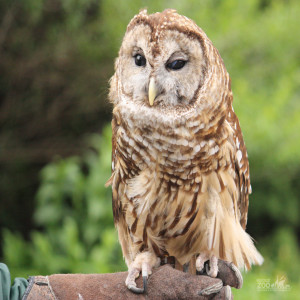Barred Owl
[Strix varia]

The Barred Owl has an overall length of 16 to 24 inches. It's wingspan is 38 to 50 inches. This is a large, rotund, gray-brown woodland owl with a puffy dome-shaped head and big, liquid black eyes. The most striking feature is a ruff of feathers, barred crosswise, on the puffy upper breast, and bold lengthwise streaks on the rest of the under-parts. The amount of richness of brown in the plumage increases from north to south; the palest birds in east-central Canada, and the darkest in extreme south Mexico.
Location: Education Animals
Share:
Range
The Barred Owl's range is Southern Canada, eastern & midwestern U.S., Mexico
Habitat
Barred Owls inhabit forests, especially deep, dark woods.
Conservation Status
Least ConcernPrimary Threats
Gestation
Gestation is 28 to 32 days.
Litter
2 to 4 eggs; usually 2
Behavior
Barred Owls sometimes hunt and even hoot during the daytime, especially in cloudy weather. Best known of its hoots is the sound described as “who cooks for you, who cooks for you all”, but it can also sound like the barking of a dog – and spit like a bobcat. They are the fourth largest North American owl. The feet are small and weak, and it seldom attacks large prey. It has virtually no predators to fear, but its tormentors are crows and goshawks. Barred owls are quite harmless and try to appear horrifying. What they lack in genuine ferocity they make up in acting ability. A barred owl will glide directly toward a birder’s eyes, break flight seconds before contact, and perch a few feet away, glowering menacingly. It will swell its neck, puff out its chest, crane its head, and distend its already bulging eyes. Then it will take a deep breath and pour out a torrent of strixine obscenities guaranteed to unhinge the listener.
Reproduction
Incubation is by the female barred owl alone. The young are brooded for about three weeks, while the male provides food, and the owlets take about 6 weeks to fledge. It is some time, however, before they reach full independence.
Wild Diet
Small rodents, birds, fish, turtles, tortoises
Zoo Diet
Strip beef, baby chicks, mice
